Christopher Allen's Blog, page 11
August 20, 2015
Crossing the Gibb by Gillian Brown
 ‘Gooday! This is Radio 3JR. Y’all having a good time out there? Down the Gibb River Road. On the stations. As far as your ears can hear? Next up is Slim Dusty.’ As our 4x4 Toyota campervan judders over the corrugated dirt track, I turn up the volume. Australia’s brand of Country & Western fills the cab. The 665-kilometre-long Gibb River Road – affectionately known as the Gibb – is a classic off-road route in Western Australia’s remote Kimberley region. The ‘beef road’, built for transporting cattle from the stations, is now popular with adventure-seeking tourists. A sign confirms all river and creek crossings are open. We feel confident – sort of – with our well-stocked fridge, two spare tyres, emergency water and fuel, and every mosquito repellent known to man. Our first stop is El Questro, a million-hectare working cattle station. The main homestead is run as a high-class resort, but we head for the riverside camping area, which includes a shop, a restaurant, a bar, and some up-market cabins. We park beneath some eucalyptus trees filled with screeching lorikeets. ‘Mind the freshies, mate!’ someone warns. Freshwater crocodiles are supposedly non-aggressive, however, my proposed soak in the nearby waterhole is postponed. After a beer, we barbecue fresh prawns and wild snapper and eat under the stars. As we crawl into bed, the distant sound of a didgeridoo lulls us to sleep.
‘Gooday! This is Radio 3JR. Y’all having a good time out there? Down the Gibb River Road. On the stations. As far as your ears can hear? Next up is Slim Dusty.’ As our 4x4 Toyota campervan judders over the corrugated dirt track, I turn up the volume. Australia’s brand of Country & Western fills the cab. The 665-kilometre-long Gibb River Road – affectionately known as the Gibb – is a classic off-road route in Western Australia’s remote Kimberley region. The ‘beef road’, built for transporting cattle from the stations, is now popular with adventure-seeking tourists. A sign confirms all river and creek crossings are open. We feel confident – sort of – with our well-stocked fridge, two spare tyres, emergency water and fuel, and every mosquito repellent known to man. Our first stop is El Questro, a million-hectare working cattle station. The main homestead is run as a high-class resort, but we head for the riverside camping area, which includes a shop, a restaurant, a bar, and some up-market cabins. We park beneath some eucalyptus trees filled with screeching lorikeets. ‘Mind the freshies, mate!’ someone warns. Freshwater crocodiles are supposedly non-aggressive, however, my proposed soak in the nearby waterhole is postponed. After a beer, we barbecue fresh prawns and wild snapper and eat under the stars. As we crawl into bed, the distant sound of a didgeridoo lulls us to sleep. An early start is essential to avoid the mid-September heat. Luckily, El Questro Gorge is only a couple of creeks’ drive away up a sandy track. Soaring cliffs and lush tropical vegetation give us shade as we climb over giant boulders and wade through waist-high creeks, shoes and cameras held high above our heads. The two-hour walk ends with a plunge into the crystal waters of a deep pool, beneath a 50m-drop waterfall. The choice of places to explore along the Gibb is narrowed down by your vehicle, its insurance cover if rented, and the state of the roads. But crossing the croc-infested Pentecost River is obligatory. Luckily, the water level is low. I hold my breath. A minute later we’re across. A short drive through the red-skirted Cockburn Ranges leads us to Home Valley Station, owned by the Indigenous Land Corporation. Its panoramic bush camp overlooks the river. An Aboriginal ranger approaches. ‘Have you seen Cedric?’ ‘Who?’ ‘He’s six metres long.’ He grins. ‘Keep back from the riverbank. It’s tidal here and full of salties.’ Unlike their freshwater cousins, saltwater crocodiles are known to attack.

After sunset, we dine at the station’s Dust Bar on succulent kangaroo loin with mashed sweet potato, and freshly-caught barramundi. The next section of the Gibb – recently graded – makes our morning’s drive to Ellenbrae smoother. The Station’s managers regale us with survival tales of their time spent cut off, during the wet season. And feed us delicious cream teas. We camp in the original Ringers’ Bush Camp – alone – which remains much as they left it. Mod cons include a flush toilet, a bath, a wood-burning BBQ and a water donkey. Fed logs, the latter provides hot showers within fifteen minutes. Above the sink a sign reads: ‘The ten most venomous spiders in the world reside here.’ More Aussie humour? Unfortunately not.
Stars cram the night sky, and once the red-tailed cockatoos quit screeching, the bush becomes eerily silent. I put all thought of predators behind me and succumb to sleep. Next day, we face our longest drive yet. The distance covered enforces itself by its sheer monotony: red dirt, eucalyptus, red dirt, eucalyptus... But the emptiness connects with something primitive in me, long lost in our modern, gadget-driven lives. Finally, some huge tyres – painted white – mark the turn-off to Mount Elisabeth Station. This 30-kilometre bone-shaking track soon covers us in red dust – outside and in. The rear door rattles ominously. A frill-necked lizard crosses our path, then freezes – immobile as a statue. Brahmin cattle munch on invisible grass, being fattened for shipment to Indonesia. As the bumps grow bumpier, the door finally drops off.
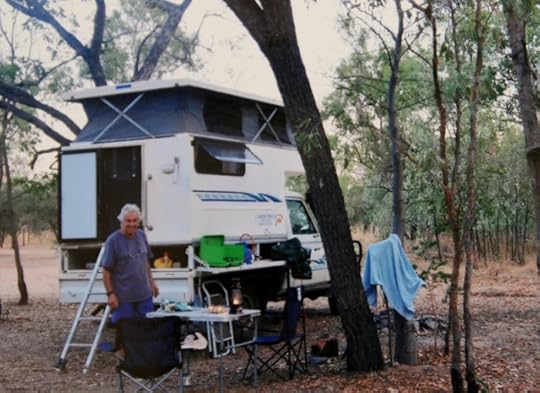
Once camped, we luxuriate in dust-removing showers, followed by dinner in the homestead. The conversation leads to the white Australian/Aborigine problem, but isn’t solved that night. Nor subsequently. Our next destination is Mornington Wilderness Camp, one of the remotest places in the Kimberley, 90 kilometres from the Gibb. The Wildlife Conservancy do research and run conservation programs here, like tagging dingoes and counting birds. The bush camp has no power to run our fan. Humidity is high, so we sleep dripping with sweat. ‘The Wet’s coming early this year,’ we’re told. At dawn, armed with paddles, we drive to Dimond Gorge. New shoots on the spinifex are a startling emerald green against the red earth. We surprise a water monitor, flocks of multi-coloured finches and a pair of bustards, who flee into the long grass. The mighty Fitzroy River cut its way through the rugged Leopold Ranges to form a gorge with 40-metre high cliffs. We collect our canoes and paddle downstream. A kind of ‘Deliverance’ feeling takes hold, but no weirdos jump out, only rock wallabies on a high ledge above us. Throwing caution to the wind, we beach our canoes and swim, despite the presence of freshies. No worries! Luckily. Our day is topped off in the Centre’s restaurant, with a candlelit dinner under the stars. Finches and wrens begin the dawn chorus, followed by ear-piercing corellas. It is only 5:30 a.m. but time to get up. Back on the Gibb, we stop for fuel at the Imintji Aboriginal Community Store. Only diesel is sold here, to counter a petrol-sniffing problem. On the door a sign reads: ‘Don’t eat rubbish fast food. Don’t touch alcohol.’ The Aborigines’ metabolism cannot process alcohol or sugar, and diabetes is rife. The store manager has recommended Bell Gorge. A steep path leads to a multi-layered waterfall with a swimming hole beneath – an earthly paradise. To submerge ourselves we slide down a slippery rock. Once refreshed, I struggle back out. A casual voice enquires, ‘See any water pythons?’ In case you haven’t gathered, teasing Pomsis a national sport. From here, the scenery changes, the red rock turning to black. Hours later, we follow a corrugated track to Windjana Gorge. As the cathedral-like cliffs glow pink in the sunset, the pale green spinifex – crouched like pincushions below – take on an ethereal light. Soon after dawn, the tranquility of our walk up the gorge is disturbed by the deafening flapping of thousands of fruit-bats coming to roost in the trees. In rock pools scattered amongst the slow-moving river, freshies vie for territory; thrashing their tails at each other and baring their teeth. Crossing the Gibb can take a few days or a few weeks. We spent somewhere in between, but whatever you decide, you’ll wish you took longer. Covered here are only personal highlights. The choice is infinite. Strangely silent, we bump our way back to the Gibb for the last time. Shortly it turns to bitumen, at the junction to a colossal mineral mine. The feeling of anti-climax hits like a rock in my stomach. ‘What day is it?’ my husband asks. ‘No idea,’ I say. ‘But I wish it was yesterday.’__________________________________________ Gillian Brown was born in Scotland. She lived in several countries before settling in France, where she ran canal cruises with her husband for several years. Her travel articles have been published in various magazines and her short stories have won and been placed in competitions.
Published on August 20, 2015 06:30
August 17, 2015
Sweet Homes by David Joseph
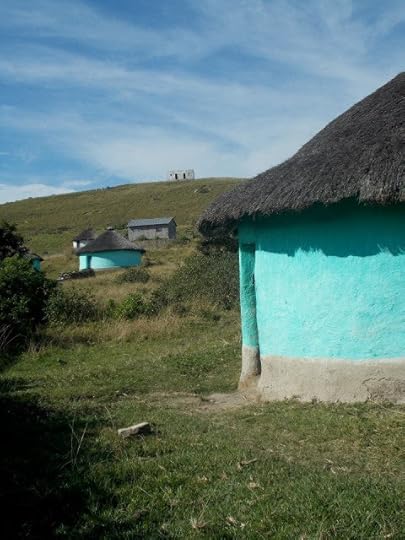 Photo by Carly BassInspirational quotes line the walls at the entrance of the Apartheid Museum in Johannesburg, South Africa, but they don’t last. The deeper I walk, the further I’m delved into gruesome realities of the not-so-distant past. Twenty-four hours ago I was in the comfort of my mother’s suburban New Jersey home and now I’m slinking through a room with footage of rebels being massacred projected onto the wall. The video is from 1992, a year after my birth. It’s 2012. I’m a week short of twenty-one years old.A hulking armored truck fills another room. Its tires rise above my waist. Its yellow hull is weathered. I can’t help imagining it as a movie prop, a replica—but it’s real. Trucks like this would be filled with non-student white males my age or younger. During their four mandatory years of military service they were equipped with body armor and assault rifles. These trucks would lumber onto university campuses and pepper activist crowds with teargas.The back hatch is open. I climb inside and sit on the cold metal bench. The windows are cracked into rippling webs from hurled stones, but the glass, like the hull, is impenetrable.Inside the truck I hear the sound of blood gushing through me, like holding my ear against a conch. This is my context for travel: vacation, novelty, a souvenir conch by which to remember the sound of waves. Suddenly I’m considering the random happenstance of my birthplace, the sheer luck that my consciousness was dropped into the body of a straight white male halfway around the globe. I remember my mom telling me when I was a child how fortunate we are to have been born in the United States. “Of all the places,” she said. “What are the odds?”
Photo by Carly BassInspirational quotes line the walls at the entrance of the Apartheid Museum in Johannesburg, South Africa, but they don’t last. The deeper I walk, the further I’m delved into gruesome realities of the not-so-distant past. Twenty-four hours ago I was in the comfort of my mother’s suburban New Jersey home and now I’m slinking through a room with footage of rebels being massacred projected onto the wall. The video is from 1992, a year after my birth. It’s 2012. I’m a week short of twenty-one years old.A hulking armored truck fills another room. Its tires rise above my waist. Its yellow hull is weathered. I can’t help imagining it as a movie prop, a replica—but it’s real. Trucks like this would be filled with non-student white males my age or younger. During their four mandatory years of military service they were equipped with body armor and assault rifles. These trucks would lumber onto university campuses and pepper activist crowds with teargas.The back hatch is open. I climb inside and sit on the cold metal bench. The windows are cracked into rippling webs from hurled stones, but the glass, like the hull, is impenetrable.Inside the truck I hear the sound of blood gushing through me, like holding my ear against a conch. This is my context for travel: vacation, novelty, a souvenir conch by which to remember the sound of waves. Suddenly I’m considering the random happenstance of my birthplace, the sheer luck that my consciousness was dropped into the body of a straight white male halfway around the globe. I remember my mom telling me when I was a child how fortunate we are to have been born in the United States. “Of all the places,” she said. “What are the odds?”The next day I fly to East London, then take a bus to Coffee Bay. The landscape skips from city to countryside without the transition of the suburbs I’ve grown up in. There are cylindrical mud huts scattered over the grassy hills. From the airplane, these villages had been tiny flecks glinting in the sun like shattered safety glass, the product of a car wreck. But now, at their level, their milky green color reminds me of charms on a bracelet strung across the unspoiled earth. The bus passes a handful of unfenced goats and I spot graffiti spray-painted across a low cliff-face, an out-of-place detail in this raw terrain. In bold black it reads: KAMO TUMI. The words aren’t in my limited repertoire of Xhosa—the language spoken in the village I’m going to—but still they have meaning. They tell me there’s no place so far away that I’ll forget where I’m from. I arrive in the Xhosa village, Tshani, in the evening. For the next few days, a native guide who goes by Tony leads me into the village each morning. Tony is twenty, lean. He speaks English well. One day I meet a woman named Nothusile. She has kind, drooping eyes. She carries her grandson on her back in a sling made from a towel. I ask if she’s ever considered living anywhere else and Tony translates.No, she says, this place is all she knows.The village is slowly transitioning into the twenty-first century. If you have a wide enough view you can usually spot a rectangular building, a trace of western architecture. The Tshani sangoma just got a DVD player in his hut.“Do you worry,” I ask Nothusile, “that the traditions of your village will be lost?”She wishes the village could remain the way it was when she grew up. She asks with a laugh if I could live in Tshani.“It’s beautiful,” I say. “I love it.” For a moment I allow myself to envision a humble life like Nothusile’s, a life in which I can slough off my privilege and build a hut from mud bricks, where having nothing means having enough. But I know, like her, I’m forever tethered to the place I’m from.
On the beach my last night in Tshani, the guides build a bonfire taller than I am. They pass around drums and we wail on them and laugh and sing in each other’s languages. I drink too much: two forties of Castle Milk Stout, something called Brutal Fruit—I drink whatever is handed to me. In the morning I recall smiles, the feel of gravel on the soles of my feet, and maybe I vomited in the ditch circling my hut. And there’s one more maybe-memory, like a ghost.I’m alone wobbling along the path toward the bathroom. Tony appears out of the dark. “What do these words mean?” I ask him, slurring. “Kamo tumi. I saw them on a cliff.” “Kamo Tumi,” he repeats. “Nothing. They don’t mean anything.” I feel cheated. Even here, the world is scarred, tainted by someone’s senseless staked claim to the physical world. I go to the bathroom and watch my piss swirl down the bowl, the opposite direction it would spiral back home. Everything here is backwards.
As the plane glides into Cape Town, it passes over a shantytown. From above it looks like a junkyard, acres of shrapnel. The romance of Tshani is gone. This is not the same modest, self-sufficient living—this place is desperate. I receive a tour of a shantytown called Sweet Homes. Outside a sign reads, “Do not kill your children out of fear or being poor.” The houses are scrap metal, plywood, and cardboard—they’re the size of walk-in closets. Chained outside are dogs beaten bow-legged, their ribs defined. The footpaths are strewn with used condoms. We come to a one-room schoolhouse the size of a trailer. I step inside to about thirty children under five. They are visibly dirty and seem startled. A guide explains that they expect whites to hate them. I feel guilty intruding, so I smile. I coo. A boy with snot trailed from one nostril to his upper lip smiles up at me. He raises his arms, silent. I plant my palms under his arms and lift him so his eyes are level with mine. He is so light. He is laughing. A line forms in front of me, smiling boys and girls waiting for their turn to be lifted by a white man who doesn’t hate them. I hug them, I hold them, and feel like I’m sinning. I fear I’m deepening their suffering by setting it alongside joy. I think, maybe it’s better if they never discover a world outside their own, if they have nothing to compare their existence to. Maybe there’s comfort in that.But it’s a selfish thought. I’m thinking of my own comforts, the luxuries I previously found commonplace that now carry a measure of guilt. If these children’s lives have been tinged by joy, mine has been stained by their despair. When I step out of the schoolhouse, the children follow. “You have to stay here,” I say to a boy pulling at my jeans pocket. The kids smile and wave. I turn away and don’t look back, because I want to lose them. I want to go so far that maybe they’ll forget.
_____________________________________________
David Joseph lives in Philadelphia with his almost-wife. He served as Co-Editor-in-Chief of Susquehanna Reviewfor its 2012 and 2013 issues. His fiction has appeared in Hobart, Big Lucks, and the W.W. Norton anthology, Hint Fiction. David’s story “Overcast” was named winner of Revolution John Magazine’s 2015 Highlander Fiction Award.
Published on August 17, 2015 06:30
August 14, 2015
Discovering Hến Rice in Central Việt Nam by Chris Galvin
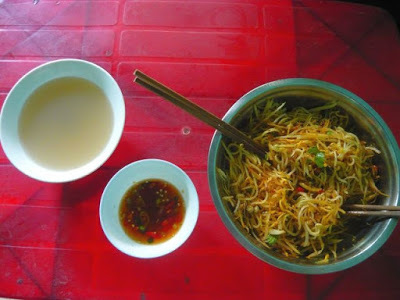 Hà shook her head and frowned. “Don’t eat hến! You’ll get stomach ache. Even some Vietnamese people can’t eat it.”
Hà shook her head and frowned. “Don’t eat hến! You’ll get stomach ache. Even some Vietnamese people can’t eat it.” “I’ll be fine,” I said. “I really like hến clams. I just had some the other day.”
“Really?” Hà’s eyes widened. “Where?”
“On Trương Định Street, near my hotel. I went with Tuấn. In fact I was going to eat breakfast there today, before you sent Sương to pick me up. ” Sương was Hà’s waitress.
I’d fled Hà Nội’s constant February drizzle and returned to sunny Huế, which I’d fallen in love with a few weeks earlier, but the rain had found me again. It sluiced down the hotel windows, rattling the panes and waking me up each morning. Sometimes my new friend Tuấn would pick me up on his way to Hà’s restaurant, where he sold tours of Huế’s historic pagodas and emperors’ mausoleums. I’d spend the morning practising my Vietnamese with the tour guides and restaurant staff. On this morning, the rain pounded so hard I was sure Tuấn would stay home. I’d planned to make a dash for the cluster of restaurants up the road from my hotel. They all served hến clams: cơm hến (with rice), cháo hến (with rice porridge), and bún hến (with rice noodles).
I’d opened my door to find Sương standing in a wet circle on the carpet, rain dripping off her poncho, jeans soaked from the knees down. I’d slid into place behind her on her motorbike, hunkering down under the rear flap of her poncho, my legs folded horizontally high above the footrests to keep them dry. It was no use. The rain sprayed up off the road and soaked me all the same.
When we arrived at the restaurant, Hà poured hot coffee and explained in English: “Tuấn busy. He say invite you for breakfast. He say you not go out in the rain.” Then she’d offered me beef noodle soup, but Sương suggested we eat cơm hến instead.
Hà switched back to Vietnamese. “You really didn’t get sick after eating hến?”
I told her I’d also tried the tiny clams on rice crackers while visiting Hội An. The waitress had watched, surprised I could eat such spicy food. Like Hà, she’d warned me about stomach aches, but I remained healthy.
“Trương Định Street is the best place for hến rice in Huế,” said Hà. “Did Tuấn take you to the big restaurant on the corner?”
“That’s where we ate. I tried all three dishes.”
Sương waved her hand as if shooing a fly. “Trương Định hến is too sweet. The best hến rice is on Cồn Hến.” She was referring to Hến Islet, which lies between the north and south shores of Huế’s Perfume River, not far from Đông Ba Market. Generations of families have made their living collecting the freshwater Corbicula clams from their alluvial beds around the island, cleaning the pea-sized molluscs and cooking them up.
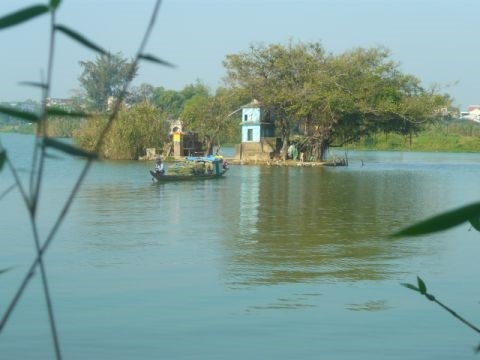
Hà and Sương argued the merits of eating at each location, pitting the three or four restaurants on Trương Định Street against all the cơm hến vendors on the islet. While they usually switched to standard Vietnamese or tried to speak slowly for me, they now peppered their rapid speech with local Huế slang; I struggled to keep up with their argument.
I finished my coffee just as the rain was sputtering out. The light reflecting off the high ochre wall across from the restaurant gave the street a golden hue. Sương stood up and grabbed my hand, ending the discussion.
“You know how to eat cơm hến, huh? Come with me! Cho vui! (For fun!)” We were on her motorbike for all of three minutes. She pulled over in front of a row of women at a makeshift sidewalk market. Shoe sellers patrolled rows of footwear. Two women squatted amidst stacks of neatly folded men’s shirts. Several more sat on Lilliputian plastic stools, tending steaming food. Sương ducked under a huge green and white umbrella advertising Huế’s Huda beer. A woman in matching short brown tunic and loose trousers was ladling broth from a battered aluminum cauldron. She smiled when she saw Sương.
The woman gestured at me with her chin. “She can eat it?”
“Yes, she knows how.”
The woman raised her eyebrows. “Can she eat spicy food?”
I assured her in Vietnamese that I really did know how to eat hến and chilis. Her eyes creased with her broad smile. “Chị không sợ đau bụng hả? (You’re not afraid of stomach ache, huh?)”
She scooped cold rice into a bowl and topped it with the silvery clams, julienned banana flowers, bitter rau má leaves, coriander, basil and bean sprouts, and pork cracklings. She sprinkled some roasted peanuts and paper-thin chili slices on top, then placed it on a stool in front of me, followed by a bowl of pale broth.
She handed me a spoon and a saucer of fish sauce with garlic, chilis and green onion slivers. “Pour this on the rice. Mix it together.”
Through the fire and sweetness of the sauce, I could taste the musky clams, balanced with the bland, crunchy cracklings and chewy cold rice. Cơm hến is as much about texture as flavour and colour. Each bite had a different ratio of sweet and salty, crunchy and soft. The hot, mild broth offset the cool but searingly spicy clam rice.
The woman told me her husband went out every morning before dawn to “scrape clams”. I couldn’t imagine how he could bear immersing himself in the cold river water to collect the clams, their shells the size of my thumbnail, from the muddy riverbed when it was barely ten degrees Celsius and raining. “He’s a good swimmer,” she said. “He’s strong. He can stand the cold, but he always comes home with shrivelled hands.”
The rain pattered on the umbrella. We huddled beneath it and I tightened my jacket collar against the chill. I sipped the broth, feeling its warmth spreading from my stomach.
We ordered the bún hến next. Though my tongue was growing numb, I discovered another layer: shredded toasted rice crackers. Almost white, they blended in with the noodles, and I didn’t see them right away.
We kept eating and listening to the hến woman talk. She was proud of her family business, but hoped her daughter wouldn’t have to cook and sell hến for a living.

“You’ll get a stomach ache!” the woman in the next stall warned me, but I hadn’t so far, and I adored Huế’s trio of hến dishes. Crisp, clean flavours that danced on my tongue, and subtle undercurrents too. I added them to my list of addictive Huế specialties like the local beef noodle soup called bún bò Huế, and bánh bột lộc, the translucent shrimp dumplings that I couldn’t get enough of.
My time in Việt Nam was almost up (though I would later return to live in Huế for several years). I told Sương I would miss hến rice.
“You know,” she said in English, “the hến, it in the heart of Huế people. When we go away, we remember. We always wish we come back, eat cơm hến.”
_______________________________________________
Chris Galvin divides her time between Canada and Việt Nam. Her essays and travel writing have appeared in many places online and in print, including Asian Cha, PRISM international, Vietnam Tourism Review, Descant, two Writers Abroad anthologies, and others. Chris is currently polishing a collection of essays about Việt Nam.
Published on August 14, 2015 06:30
August 12, 2015
A Vision Called Tutotepec by Maricarmen Ferrant
Tutotepec, affectionately called "Tuto" by its handful of residents, is nestled among the many peaks of the Sierra Madre Oriental in the State of Hidalgo, Mexico. On our first trip way back in 1997, we felt as if we were embarking on an odyssey not at all sure we would we be able to find this then speck on the map.
The first part of the trip was easy. We left Mexico City early and took the highway towards Tulancingo. The cut-off to San Barolo was there on our left. As we turned onto it, we knew that we were not just taking another road: we were traveling to another dimension. Soon our known reality would disappear behind us. Near Santa Ana Hueytlapan, we passed a procession of Otomi women carrying wax candles, baskets laden with food and beautiful crosses made of cempasúchitl(holiest of Aztec flowers and known the world over as marigolds). They wore home-woven thick black skirts and beautifully embroidered white huipiles (blouses). The bright colored ribbons braided into their jet-black hair had caught our attention before we reached them. Slowing down, we heard their prayers. I waved to them, and a few of the younger girls could not resist the temptation and smiled shyly in return. Then we saw the men: in blinding white cotton clothes, straw hat and glistening machete resting on their shoulder.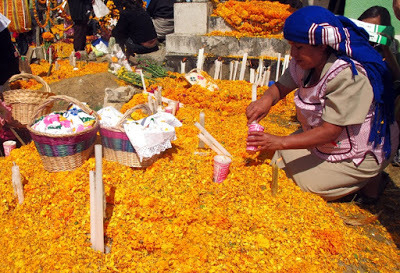 After Tenango de Doria, the road seemed to play hide and seek with the mountains, and the lusciously green scenery was hard to resist. A picnic pause would be great, but "Tuto" could not wait.
After Tenango de Doria, the road seemed to play hide and seek with the mountains, and the lusciously green scenery was hard to resist. A picnic pause would be great, but "Tuto" could not wait.
Finally, we reached San Bartolo. Now all we had to do was find the road that would lead us to Tutotepec, located somewhere in the mountains. But which one was the yellow brick road? Suddenly, I spotted a trail of cempasúchitlflowers. Divine intervention? Perhaps. On a hunch, we decided to follow them. A few kilometers and many centuries later we arrived.
Tutotepec can hardly be called a village. A governmental store for very basic needs, a small clinic that only opens a few days per month, the derelict church with its adjoining cemetery is all that the town has to offer. The Otomi Indians that have not migrated to the cities still live in tight-knit family units scattered around the mountains and only come to Tuto for important celebrations, such as the Day of the Dead.
As we walk toward the town square, we notice a flurry of activity. Passenger cars drop off their passengers, others arrive on foot and still others on horseback. Today on November first Tutotepec will remember their departed loved ones and catch up with old friends and neighbors. A typical Mexican village scene, when all of the sudden the scores of a basketball game being played by teenagers interrupt the conversations of men dressed in jeans and Texan hats talking with their compadres. In the cemetery, the women are preparing everything for this most moving festivity. Communities all over Mexico honor their dead, but here we are outsiders; we are city people. Walking towards the cemetery, we see a woman making fresh tortillas. When did we eat? We quickly devour a couple of tacos.
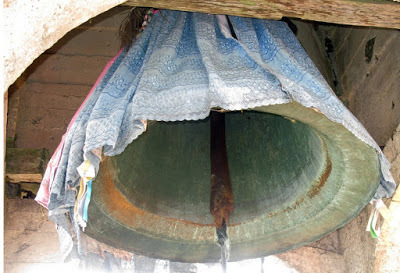 The cemetery is bulging at its seams. As he walks among the tombs, my tall, bearded French husband stands out like a beacon. The women lower their eyes and discretely laugh behind their hands. As I stop to admire their work, they greet me by lightly brushing their fingertips against mine. We smile more than talk. They ask me if my husband is a gringo and do not know what to say when I say answer that he is French. They laugh politely not knowing if that is good or bad. However, they are amazed when I tell them that I am from Mexico City. The City is a place of magic and wonder; nothing is more important than the ancient Tenochtitlan capital of the proud and mythic Aztecs.
The cemetery is bulging at its seams. As he walks among the tombs, my tall, bearded French husband stands out like a beacon. The women lower their eyes and discretely laugh behind their hands. As I stop to admire their work, they greet me by lightly brushing their fingertips against mine. We smile more than talk. They ask me if my husband is a gringo and do not know what to say when I say answer that he is French. They laugh politely not knowing if that is good or bad. However, they are amazed when I tell them that I am from Mexico City. The City is a place of magic and wonder; nothing is more important than the ancient Tenochtitlan capital of the proud and mythic Aztecs.
The tombs are barely visible under the mounds of marigolds. Everything is ready: decorated crosses, lighted candles and straw baskets burdened with the favorite delicacies of their departed loved ones wait for their arrival. While the family waits, they listen to the music being played by a trio here, a quartet there. An air of expectancy floats in the air. They are not sad because the tombs will soon be blessed ensuring that the yearly rendezvous will take place again.
However, if we want to visit what remains of the Augustine church and see the bell, we must hurry. The mist has already covered the summits of the surrounding mountains. There are no benches inside, but in front of the altar two men with their hats and bowed down pray that the Padrecito, will arrive before the fog hides Tutotepec.
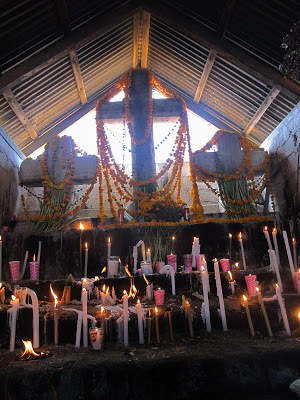 We find the cramped winding stair and grope our way to the top. There she is. The Bell, the pride of Tuto and personification of Marie Magdalene and of Ometecuhtli,an ancient goddess to whom they still pray. The residents of nearby San Bartolo have tried to steal the Bell, but each time it mysteriously reappears in her rightful place. She is the guardian of Tuto. As long as she reigns over the cemetery, the departed will be protected from malignant forces.
We find the cramped winding stair and grope our way to the top. There she is. The Bell, the pride of Tuto and personification of Marie Magdalene and of Ometecuhtli,an ancient goddess to whom they still pray. The residents of nearby San Bartolo have tried to steal the Bell, but each time it mysteriously reappears in her rightful place. She is the guardian of Tuto. As long as she reigns over the cemetery, the departed will be protected from malignant forces.
I get as close as I dare to the edge. The fog shrouds the cemetery, but here and there I can see a flickering candle or orange and yellow bursts of marigolds. The aroma of Copal, ancient Aztec incense perfumes the prayers that transformed into murmurs float in the air.
Suddenly, a banner and three crosses appear. They wind their way through the cemetery. We hear, more than see, tubas, trumpets, and a large drum and men singing. We are told that a new cofradia is about to be sworn in. But that is a private ceremony, and we are intruders.
I want to know more, but time is of the essence if we want to find our way back to our so-called modern and civilized world. Before the bend in the road that will hide Tutotepec, I turn for a last glimpse. Am I dreaming? Or is the trail of cempasúchitl flowers slowly being erased by cautious souls?
_____________________________________________
Maricarmen Ferrant was born in Mexico City. Following her husband, she has crisscrossed the world, living in Chicago, Buenos Aires, Nantes, Diego Suarez (Madagascar) and Mumbai. She now resides in Mexico City. She is an amateur photographer and promoter of Mexico.
The first part of the trip was easy. We left Mexico City early and took the highway towards Tulancingo. The cut-off to San Barolo was there on our left. As we turned onto it, we knew that we were not just taking another road: we were traveling to another dimension. Soon our known reality would disappear behind us. Near Santa Ana Hueytlapan, we passed a procession of Otomi women carrying wax candles, baskets laden with food and beautiful crosses made of cempasúchitl(holiest of Aztec flowers and known the world over as marigolds). They wore home-woven thick black skirts and beautifully embroidered white huipiles (blouses). The bright colored ribbons braided into their jet-black hair had caught our attention before we reached them. Slowing down, we heard their prayers. I waved to them, and a few of the younger girls could not resist the temptation and smiled shyly in return. Then we saw the men: in blinding white cotton clothes, straw hat and glistening machete resting on their shoulder.
 After Tenango de Doria, the road seemed to play hide and seek with the mountains, and the lusciously green scenery was hard to resist. A picnic pause would be great, but "Tuto" could not wait.
After Tenango de Doria, the road seemed to play hide and seek with the mountains, and the lusciously green scenery was hard to resist. A picnic pause would be great, but "Tuto" could not wait.Finally, we reached San Bartolo. Now all we had to do was find the road that would lead us to Tutotepec, located somewhere in the mountains. But which one was the yellow brick road? Suddenly, I spotted a trail of cempasúchitlflowers. Divine intervention? Perhaps. On a hunch, we decided to follow them. A few kilometers and many centuries later we arrived.
Tutotepec can hardly be called a village. A governmental store for very basic needs, a small clinic that only opens a few days per month, the derelict church with its adjoining cemetery is all that the town has to offer. The Otomi Indians that have not migrated to the cities still live in tight-knit family units scattered around the mountains and only come to Tuto for important celebrations, such as the Day of the Dead.
As we walk toward the town square, we notice a flurry of activity. Passenger cars drop off their passengers, others arrive on foot and still others on horseback. Today on November first Tutotepec will remember their departed loved ones and catch up with old friends and neighbors. A typical Mexican village scene, when all of the sudden the scores of a basketball game being played by teenagers interrupt the conversations of men dressed in jeans and Texan hats talking with their compadres. In the cemetery, the women are preparing everything for this most moving festivity. Communities all over Mexico honor their dead, but here we are outsiders; we are city people. Walking towards the cemetery, we see a woman making fresh tortillas. When did we eat? We quickly devour a couple of tacos.
 The cemetery is bulging at its seams. As he walks among the tombs, my tall, bearded French husband stands out like a beacon. The women lower their eyes and discretely laugh behind their hands. As I stop to admire their work, they greet me by lightly brushing their fingertips against mine. We smile more than talk. They ask me if my husband is a gringo and do not know what to say when I say answer that he is French. They laugh politely not knowing if that is good or bad. However, they are amazed when I tell them that I am from Mexico City. The City is a place of magic and wonder; nothing is more important than the ancient Tenochtitlan capital of the proud and mythic Aztecs.
The cemetery is bulging at its seams. As he walks among the tombs, my tall, bearded French husband stands out like a beacon. The women lower their eyes and discretely laugh behind their hands. As I stop to admire their work, they greet me by lightly brushing their fingertips against mine. We smile more than talk. They ask me if my husband is a gringo and do not know what to say when I say answer that he is French. They laugh politely not knowing if that is good or bad. However, they are amazed when I tell them that I am from Mexico City. The City is a place of magic and wonder; nothing is more important than the ancient Tenochtitlan capital of the proud and mythic Aztecs.The tombs are barely visible under the mounds of marigolds. Everything is ready: decorated crosses, lighted candles and straw baskets burdened with the favorite delicacies of their departed loved ones wait for their arrival. While the family waits, they listen to the music being played by a trio here, a quartet there. An air of expectancy floats in the air. They are not sad because the tombs will soon be blessed ensuring that the yearly rendezvous will take place again.
However, if we want to visit what remains of the Augustine church and see the bell, we must hurry. The mist has already covered the summits of the surrounding mountains. There are no benches inside, but in front of the altar two men with their hats and bowed down pray that the Padrecito, will arrive before the fog hides Tutotepec.
 We find the cramped winding stair and grope our way to the top. There she is. The Bell, the pride of Tuto and personification of Marie Magdalene and of Ometecuhtli,an ancient goddess to whom they still pray. The residents of nearby San Bartolo have tried to steal the Bell, but each time it mysteriously reappears in her rightful place. She is the guardian of Tuto. As long as she reigns over the cemetery, the departed will be protected from malignant forces.
We find the cramped winding stair and grope our way to the top. There she is. The Bell, the pride of Tuto and personification of Marie Magdalene and of Ometecuhtli,an ancient goddess to whom they still pray. The residents of nearby San Bartolo have tried to steal the Bell, but each time it mysteriously reappears in her rightful place. She is the guardian of Tuto. As long as she reigns over the cemetery, the departed will be protected from malignant forces.I get as close as I dare to the edge. The fog shrouds the cemetery, but here and there I can see a flickering candle or orange and yellow bursts of marigolds. The aroma of Copal, ancient Aztec incense perfumes the prayers that transformed into murmurs float in the air.
Suddenly, a banner and three crosses appear. They wind their way through the cemetery. We hear, more than see, tubas, trumpets, and a large drum and men singing. We are told that a new cofradia is about to be sworn in. But that is a private ceremony, and we are intruders.
I want to know more, but time is of the essence if we want to find our way back to our so-called modern and civilized world. Before the bend in the road that will hide Tutotepec, I turn for a last glimpse. Am I dreaming? Or is the trail of cempasúchitl flowers slowly being erased by cautious souls?
_____________________________________________
Maricarmen Ferrant was born in Mexico City. Following her husband, she has crisscrossed the world, living in Chicago, Buenos Aires, Nantes, Diego Suarez (Madagascar) and Mumbai. She now resides in Mexico City. She is an amateur photographer and promoter of Mexico.
Published on August 12, 2015 06:30
August 10, 2015
Burning My Boots in Cabo Fisterra by Gabriella Brand
 “Come with me to the ends of the earth,” joked Miguel, a handsome Andalusian who was young enough to have been my son. “The ends of the earth?” I repeated, unsure if I had understood his rippling Spanish. We were strangers who had just met a few hours before. Both of us had taken shelter from the rain inside a Santiago café.“Cabo Fisterra,” said Miguel. “It’s only a three-day walk from here.”Three days? I could certainly walk three more days. I’d just finished walking alone for five hundred miles across Spain on the Camino Frances, starting out from Saint Jean Pied de Port in France. Miguel, too, had just completed a solitary pilgrimage, coming up from Seville and following the Mozárabe route to Santiago. “And you can burn your boots when you get to Fisterra,” said Miguel.I looked down at my boots. They were mud-encrusted and the heels were worn. For a minute I questioned in my head whether the Spanish verb quemar really meant to burn.“In the Middle Ages, pilgrims first went to Santiago, then they would continue on to Fisterra and they’d burn their clothes or shoes there,” Miguel explained.“Because they probably stunk,” I said.“Or as a sacrifice, to give thanks,” said Miguel. I was silent for a minute. Something about giving thanks choked me up a bit.“So, will you come along?’’ he asked.Now if I had been a young woman, I would have assumed that Miguel was trying to seduce me. But he had already told me – within a few minutes of our meeting - that I reminded him of his grandmother. “You have a kind smile just like my Abuela,” he said. “But she could never walk a Camino like you. Nunca. She has bunions, and other problems.”I kept to myself the knowledge that I, too, had bunions and arthritic toes. At that moment, I was grateful that my aging body worked at all. I was sixty-five. “And what else is there in Fisterra?” I asked.“Magic,” he said, softly.Like all charming men, Miguel must have sensed something about me that I didn’t know myself.“You don’t want your pilgrimage to come to an end, do you?” he asked quietly.“Not really,” I said, “I’ve got a bit of a let-down feeling. But all things end, I suppose.” “Yes, yes, that is true. But the earth comes to an end too, and you should see it.”I laughed. I knew that there were several places on earth with that ancient distinction. Lands’ End in England. Finisterre in Brittany. Finis terrae, said the Romans. “Fisterra is waiting for you,” he said. “I leave at dawn,” he added, dramatically.
“Come with me to the ends of the earth,” joked Miguel, a handsome Andalusian who was young enough to have been my son. “The ends of the earth?” I repeated, unsure if I had understood his rippling Spanish. We were strangers who had just met a few hours before. Both of us had taken shelter from the rain inside a Santiago café.“Cabo Fisterra,” said Miguel. “It’s only a three-day walk from here.”Three days? I could certainly walk three more days. I’d just finished walking alone for five hundred miles across Spain on the Camino Frances, starting out from Saint Jean Pied de Port in France. Miguel, too, had just completed a solitary pilgrimage, coming up from Seville and following the Mozárabe route to Santiago. “And you can burn your boots when you get to Fisterra,” said Miguel.I looked down at my boots. They were mud-encrusted and the heels were worn. For a minute I questioned in my head whether the Spanish verb quemar really meant to burn.“In the Middle Ages, pilgrims first went to Santiago, then they would continue on to Fisterra and they’d burn their clothes or shoes there,” Miguel explained.“Because they probably stunk,” I said.“Or as a sacrifice, to give thanks,” said Miguel. I was silent for a minute. Something about giving thanks choked me up a bit.“So, will you come along?’’ he asked.Now if I had been a young woman, I would have assumed that Miguel was trying to seduce me. But he had already told me – within a few minutes of our meeting - that I reminded him of his grandmother. “You have a kind smile just like my Abuela,” he said. “But she could never walk a Camino like you. Nunca. She has bunions, and other problems.”I kept to myself the knowledge that I, too, had bunions and arthritic toes. At that moment, I was grateful that my aging body worked at all. I was sixty-five. “And what else is there in Fisterra?” I asked.“Magic,” he said, softly.Like all charming men, Miguel must have sensed something about me that I didn’t know myself.“You don’t want your pilgrimage to come to an end, do you?” he asked quietly.“Not really,” I said, “I’ve got a bit of a let-down feeling. But all things end, I suppose.” “Yes, yes, that is true. But the earth comes to an end too, and you should see it.”I laughed. I knew that there were several places on earth with that ancient distinction. Lands’ End in England. Finisterre in Brittany. Finis terrae, said the Romans. “Fisterra is waiting for you,” he said. “I leave at dawn,” he added, dramatically.
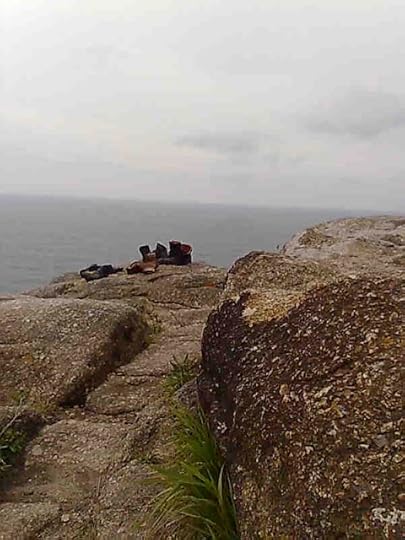 From café window, I sat and watched the arrival of more and more soggy pilgrims in the cathedral plaza. Some were embracing or crying, others were wandering around in a daze. The long anticipated trek was over…the damp Pyrenees, the red clay of Rioja, the dry Meseta, the cow dung of Galicia. And now, suddenly, this young stranger was putting a bug in my ear, beckoning me to the sea. I started to envision dinners of fresh fish, wide empty beaches, and days of sunshine. Did I mention that Santiago was thick with grey clouds and a hint of sadness?So I set off. But not with Miguel.I assume he left the refugio early the next morning. This particular grandmother needed to eat breakfast and find a washing machine and take a day or two of rest. Practicality before magic.I pictured Fisterra like Cape Hatteras, where, decades ago, my husband and I had climbed the lighthouse with our baby son jiggling in a back pack. Windy and invigorating. Or maybe it would be like the Danish island of Møn, in the Baltic, where we had gone family camping. The smell of the sea stayed in our clothes for weeks. I would find out.The route to the coast wasn’t particularly difficult. I walked slowly. Miguel, being young and fast, would have come and gone by the time I arrived.When I got to Fisterra, I could see a small hotel, a few restaurants, and blue fishing boats bobbing in the harbor. The actual end of the promontory was up another hill. I would walk there later, but for now, I needed a place to stay. I began looking round the Plaza del Ara Solis. And that’s when the magic started.“Senora, I have a good house,” said a voice behind me. I turned and saw a woman who had a toddler in one hand and a market basket in the other. “Perdón?” I said.“I’ll rent you a room. Cheap.”A place to stay fell into my lap, just as if I had been granted a wish by a genie.Under ordinary circumstances, I wouldn’t follow a stranger to her house. But Fisterra is part of the pilgrim world and has been a spiritual place for millennia. I was not the first soul to be lodged by one of its inhabitants. We exchanged names. I followed Bianca to her mother-in -law’s where she left her toddler and some of the onions from her market basket.“Now we’ll go up to my house,” she said.She led me through a maze of lanes. With each step, we got higher and higher, the roaring sea dropping below us on either side.
From café window, I sat and watched the arrival of more and more soggy pilgrims in the cathedral plaza. Some were embracing or crying, others were wandering around in a daze. The long anticipated trek was over…the damp Pyrenees, the red clay of Rioja, the dry Meseta, the cow dung of Galicia. And now, suddenly, this young stranger was putting a bug in my ear, beckoning me to the sea. I started to envision dinners of fresh fish, wide empty beaches, and days of sunshine. Did I mention that Santiago was thick with grey clouds and a hint of sadness?So I set off. But not with Miguel.I assume he left the refugio early the next morning. This particular grandmother needed to eat breakfast and find a washing machine and take a day or two of rest. Practicality before magic.I pictured Fisterra like Cape Hatteras, where, decades ago, my husband and I had climbed the lighthouse with our baby son jiggling in a back pack. Windy and invigorating. Or maybe it would be like the Danish island of Møn, in the Baltic, where we had gone family camping. The smell of the sea stayed in our clothes for weeks. I would find out.The route to the coast wasn’t particularly difficult. I walked slowly. Miguel, being young and fast, would have come and gone by the time I arrived.When I got to Fisterra, I could see a small hotel, a few restaurants, and blue fishing boats bobbing in the harbor. The actual end of the promontory was up another hill. I would walk there later, but for now, I needed a place to stay. I began looking round the Plaza del Ara Solis. And that’s when the magic started.“Senora, I have a good house,” said a voice behind me. I turned and saw a woman who had a toddler in one hand and a market basket in the other. “Perdón?” I said.“I’ll rent you a room. Cheap.”A place to stay fell into my lap, just as if I had been granted a wish by a genie.Under ordinary circumstances, I wouldn’t follow a stranger to her house. But Fisterra is part of the pilgrim world and has been a spiritual place for millennia. I was not the first soul to be lodged by one of its inhabitants. We exchanged names. I followed Bianca to her mother-in -law’s where she left her toddler and some of the onions from her market basket.“Now we’ll go up to my house,” she said.She led me through a maze of lanes. With each step, we got higher and higher, the roaring sea dropping below us on either side.
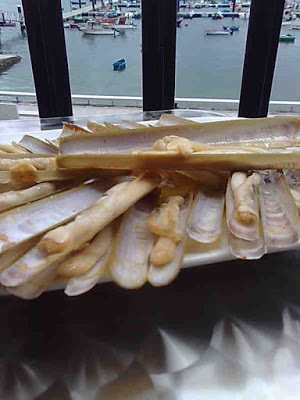 Bianca showed me to a room on the second floor. From the window I could look out on the Atlantic, churning frothy blue and endless. Fresh laundry snapped on a clothesline in the wind. I took off my boots and my backpack and stretched out on the bed. A real bed. A clean bed that smelled of citrus. On the Camino,I had grown accustomed to sleeping on sticky plastic sheeting, with a bad-breathed woman or a snoring man on either side of me.I knew I would sleep well that night.I put my boots back on. Bianca said there was a path which led down to the water. Braving the wind, I hiked to a wide circular beach. I breathed in the iodized air and threw stones into the Atlantic. I thought about the same ocean sloshing back and forth between the Iberian Peninsula and my home near New York. I thought about all the peoples who had come to Fisterra over the centuries, all with their stories. Later, after a welcome shower, I walked to a restaurant in the village. The first course was an array of shellfish. I gorged myself. Before I went to bed, I looked at the night sky and thought about my good fortune. Tomorrow I would go to the very tip of the Cabo, following the same path that the ancient Celts and Romans had trod. I was pretty sure that I wouldn’t set fire to my boots. But maybe I would say a prayer of gratitude to the gods for bringing an old lady with bunions all the way to the end of the earth.
Bianca showed me to a room on the second floor. From the window I could look out on the Atlantic, churning frothy blue and endless. Fresh laundry snapped on a clothesline in the wind. I took off my boots and my backpack and stretched out on the bed. A real bed. A clean bed that smelled of citrus. On the Camino,I had grown accustomed to sleeping on sticky plastic sheeting, with a bad-breathed woman or a snoring man on either side of me.I knew I would sleep well that night.I put my boots back on. Bianca said there was a path which led down to the water. Braving the wind, I hiked to a wide circular beach. I breathed in the iodized air and threw stones into the Atlantic. I thought about the same ocean sloshing back and forth between the Iberian Peninsula and my home near New York. I thought about all the peoples who had come to Fisterra over the centuries, all with their stories. Later, after a welcome shower, I walked to a restaurant in the village. The first course was an array of shellfish. I gorged myself. Before I went to bed, I looked at the night sky and thought about my good fortune. Tomorrow I would go to the very tip of the Cabo, following the same path that the ancient Celts and Romans had trod. I was pretty sure that I wouldn’t set fire to my boots. But maybe I would say a prayer of gratitude to the gods for bringing an old lady with bunions all the way to the end of the earth._______________________________________________Gabriella Brand’s writing has appeared in a variety of little magazines and several anthologies, including two travel collections. One of her short stories was nominated for a Pushcart Prize in 2014. Gabriella divides her year between New Haven, Connecticut, where she teaches, and Quebec, where she hikes, canoes, and daydreams. She speaks several languages, which she likes to practice by wandering around Europe and Asia. Preferably on foot.
Published on August 10, 2015 06:30
August 7, 2015
Vientiane: Then and Now by Barbara Amalberti
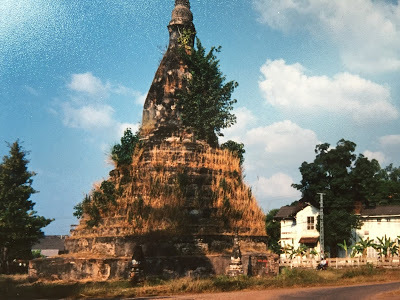 Vientiane in 1989
Vientiane in 1989For days I had being sitting under the banana trees, in the lush garden of the small guesthouse, looking at the other side of the Mekong, where the elusive and forbidden country of Laos lay.
I couldn’t help overhearing the conversation at the next table. Three young men, speaking with a variety of accents, were discussing the possibility of crossing to Laos. ‘I’ve heard we can get some sort of a visa somewhere in town,’ one of them was saying. ‘It’s expensive, but it will be worth it. Can you imagine the stories we’ll have to tell?’I smiled: the thought had never crossed my mind. How could you get a visa? Weren’t the borders closed? I found myself absorbed in their planning. ‘Why don’t you come with us?’ asked one of the guys, noticing my interest and inviting me to sit with them. Before I knew it I was part of the adventure. Two days later we were in a dark, smelly office in an alley, in a less than salubrious part of Nong Khai. A fan was blowing in a corner but it did little to alleviate the heat of the stuffy room. A Thai man with a sly smile and high cheekbones, unusual for a Thai, handed back our passports. ‘Your visas,’ he said. We looked at each other with nervous anticipation.On 9th December 1989 we walked down the steps toward the entrancing waters of the Mekong and hopped into a flimsy boat, with our pale faces, big eyes, backpacks and dodgy visas. Not long after I stepped off the boat, taking care not to slip in the mud. I was in Laos, a closed country, a communist country; I couldn’t help feeling a shiver of fear and excitement running down my spine. We were going to spend two days with a guide, staying in a government-run hotel in town and then we were free to go. We had ten days to explore Laos on our own and at our own risk. ‘This is our car,’ said our guide, pointing to a battered old mini-van. We made our way slowly into town, on a bumpy, empty road, driving past run-down temples and markets that looked bare and almost deserted. When we stopped, I jumped out and picked up my backpack. I looked at the big hotel in front of me, a featureless and austere building that intimidated and fascinated me at the same time. The rows of windows opened on a long balcony, the paint was pealing from the façade and the big car park at the front was empty. I soon realised that Vientiane’s charm was not in what was there, but in what wasn’t. No shopping streets lined with stalls selling cheap sundresses and music tapes, no locals offering to take you to the best guesthouse in town, no traffic stopping you from crossing the roads. I wasn’t fazed by the fact that there were no queues, because there was nothing to queue for. Walking the quiet streets, stopping to look at abandoned temples and old stupas overgrown with dried up grass was all I needed to be perfectly content. Although the French left Laos in 1954, their influence was everywhere. I walked past the Bibliothèque Nationale, and the closed shutters of the old building made me wonder what ghosts of a bygone era now inhabited the place. The Palais Presidentiel would have been imposing once, but it now stood lonely and worn out, like a defeated old man who has lost his purpose in life. Vientiane felt like a village abandoned by its inhabitants.
******
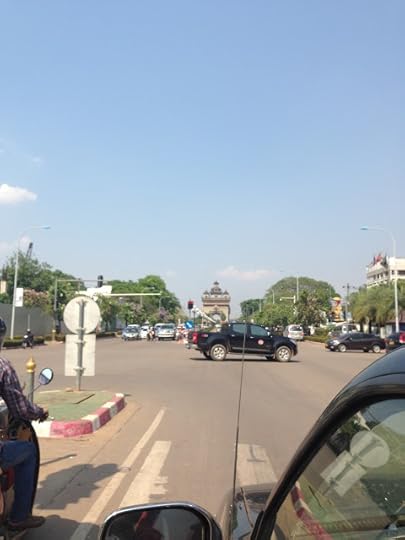 Vientiane in 2015
Vientiane in 2015It’s March 2015 and I am about to cross the Mekong again. There is a bridge now in Nong Khai, the Friendship Bridge, opened in 1994, but the boats are still there. They don’t transport people anymore, only goods. I watch them going back and forward, full of huge bags of food, double mattresses, fans, television sets…I even see a couple of washing machines. I wonder how they stay afloat.
I cross that bridge with my husband Nigel and our two teenage daughters, Julia and Sofia. This time we have a proper visa, delivered efficiently by the immigration officer at the border. ‘It’s expensive’, Nigel whispers to me as he hands over the money. ‘Yes, but it will be worth it. Think of all the stories we’ll have to tell!’I have booked two rooms in a guesthouse, amazed by the choice of hotels, big and small, now available in Vientiane. Michael, the guesthouse owner, is waiting for us in a small café, in a narrow alley opposite the Ministry of Health. ‘Welcome!’ he says when we arrive, and I find myself enveloped in his embrace. Like meeting a long lost uncle. Michael is no ordinary host. We drive through the heavy traffic. New buildings are popping up everywhere; the city is like a giant construction site. ‘This is a new mall.’ Michael points to a green and orange building to our left ‘They are sprouting everywhere, but most of them will never be used.’ Apparently there is money to be spent in Laos but it’s not necessarily spent wisely. The next day Michael takes us for what he calls a “windscreen tour” of Vientiane. As we sit in the comfort of his air-conditioned pick-up truck, he shares his knowledge and love of Vientiane and Laos.The whole town looks freshly painted and new. Michael tells us about some of the horrors of the Vietnam War. At the COPE visitor centre, we get out of the car to explore. Julia stops in front of a harrowing metal statue of a woman and child, in a patch of overgrown grass.‘Are these cluster bombs?’ she asks.‘Yes,’ Michael replies. ‘These tiny components are the most common cause of injuries by unexploded devices here. For many people the war is far from over.’The small museum, part of a rehabilitation hospital, aims to increase awareness about the issue and highlights the amazing work done to help people with disabilities lead more fulfilling and productive lives. Michael’s tour of the centre is engaging and compassionate, at times I feel tears pricking my eyes but his humour never fails to make us smile. Late in the afternoon we meet Xoukiet, Michael’s wife, and we accompany her to the market to buy food for our dinner. ‘There are so many cars!’ I say to Xoukiet.‘In the last couple of years it has become very popular to buy cars in instalments: everyone now can own a car.’ She explains that the problem is the roads haven’t been upgraded and this is what causes the traffic chaos. The market is packed with food, fresh and cooked, a real feast for the eyes and nose. Xoukiet jabbers to the sellers, handing over bundles of kips and laughing as she passes yet another bag to Nigel. At home we sit around the big wooden table, beautifully set and laden with local delights. As we share our final meal of the holiday, I muse how this time around, Vientiane’s charm lies in what is there, rather than in what isn’t.
___________________________________________
Barbara Amalberti is originally from Italy and, after a few years of nomadic living, she moved to Australia in 1991. She lives in Melbourne with her Australian husband and their two teenage daughters and is a counsellor specialised in working with migrants.
Published on August 07, 2015 06:30
August 6, 2015
A Leaf in the Wind by Joel Hindson
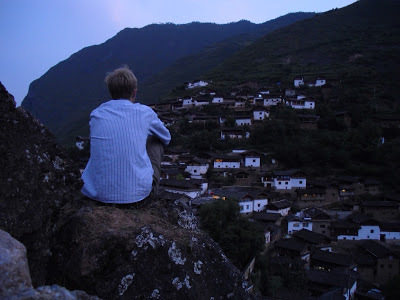 “Méiyŏu.” The two syllables dropped like dead weights onto the ticket counter and my heart sank.My Chinese was rudimentary at best, but I had by then learnt the various meanings of 'méiyŏu': don't have; cannot; not possible; end of the line, buddy; I don't know, so stop bothering me. It usually was accompanied by a shrug, always precipitated the thwarting of my plans and never failed to inspire despair.The ticket agent offered a lazy shrug and returned to her magazine.I was crestfallen. There was no bus. I would have to spend the last days of my trip in the over-touristed old town of Lijiang, its cobble-stoned labyrinths and arched bridges marred by DSLR-wielding throngs and standstill human traffic. I turned to the crowd outside, resigned to my fate.“Shitoucheng!” A beer-bellied man exclaimed, standing in my way. Shitoucheng, a remote farming village in the mountains of eastern Yunnan, was the destination to which I had hoped to escape, so, a little bewildered, I nodded.He beamed beneath a Nike baseball cap, nodded quickly, and busied himself with a pen and paper. When he pressed it into my hand it was scrawled spidery black characters. Taking me outside, he flagged a taxi, stowed me safely in the backseat, shouted and flapped his hands at the driver for several minutes, then turned to beam at me again as the taxi pulled away.
“Méiyŏu.” The two syllables dropped like dead weights onto the ticket counter and my heart sank.My Chinese was rudimentary at best, but I had by then learnt the various meanings of 'méiyŏu': don't have; cannot; not possible; end of the line, buddy; I don't know, so stop bothering me. It usually was accompanied by a shrug, always precipitated the thwarting of my plans and never failed to inspire despair.The ticket agent offered a lazy shrug and returned to her magazine.I was crestfallen. There was no bus. I would have to spend the last days of my trip in the over-touristed old town of Lijiang, its cobble-stoned labyrinths and arched bridges marred by DSLR-wielding throngs and standstill human traffic. I turned to the crowd outside, resigned to my fate.“Shitoucheng!” A beer-bellied man exclaimed, standing in my way. Shitoucheng, a remote farming village in the mountains of eastern Yunnan, was the destination to which I had hoped to escape, so, a little bewildered, I nodded.He beamed beneath a Nike baseball cap, nodded quickly, and busied himself with a pen and paper. When he pressed it into my hand it was scrawled spidery black characters. Taking me outside, he flagged a taxi, stowed me safely in the backseat, shouted and flapped his hands at the driver for several minutes, then turned to beam at me again as the taxi pulled away.
 I was deposited at a marketplace and presented to a vendor on whose fold-up table lay the slimy inhabitants of a distant ocean. I tried not to stare at the glistening mess of tentacles as he read my missive. Without a word, he directed me to the center of the marketplace and indicated that I should wait. I was beginning to feel like a leaf on the wind, my own fate out of my control; I decided to surrender to it.A weak breeze stirred the stench of garbage and old fish. Beneath a stall, an off-white cat waited patiently, grooming her matted fur, and around her wove men with tattoos and branded hi-tops, balancing polystyrene crates on their shoulders. Women and children stepped gingerly over deep-crimson stains on the ground, and customers peered at leafy greens as vendors bellowed their wares.A man – man #1 – approached. He passed me rapidly into the care of man #2, who seemed to own a vehicle. Men #3 and #4 then entered into a heated debate with man #2, and I was subsequently led away by the victor: man #5. He placed me in the passenger seat of a grubby delivery truck and we drove off. Such is the life of an English-speaking traveler in China, I thought, as we sped along the teeming, potholed arteries of Lijiang.Within minutes, we stopped. My driver had clearly dealt with foreigners in the past, and concluded that we were all imbeciles with whom communication is hopeless. To get my attention, he grunted and waggled a hand in my face, and instead of attempting language he preferred to perform ridiculously exaggerated mimes. Thus I surmised that we were stopping because he wanted to take an enormous bite out of a giant sandwich. In fact, he had noodle soup, eyes fixed in moody silence on the bowl as I made halting attempts at Chinese conversation.Back in the truck, we drove a thrilling twenty meters before stopping again. This time, the mime was indecipherable, so I allowed myself to be led through an open-front garage and into someone's bedroom. My driver left. It wasn't long before I realized he had driven off.The musty room was about the size and smell of four portaloos. On its walls were glossy pin-ups of magnificently-endowed Chinese girls in superhero costumes and on its floor sat three men on upturned boxes. The room was dimly lit, presumably for the benefit of a fifth man, who was sleeping soundly in bed.The men were passionate chain-smokers. A heavy fog choked the air, moving in great lazy swirls whenever it was disturbed. Through the smoky gloom, I watched the men prepare something whilst chatting in soft voices: into a bamboo tube was poured an egg, hot water, powders of scarlet and orange, a fatty liquid, and lumps of something unidentifiable. The bamboo was corked and shaken vigorously, then, a boyish grin on his face, one man passed me a cup. It resembled hot, congealed mud. I gulped it down in one and nearly vomited.When my driver returned, the three men took their seats in the van. As I approached the door, however, it was shut in my face. A finger pointed to the tarpaulin-covered back of the truck; a grunt and a mime confirmed my fears. My protestations were met with nonplussed silence, so, resigned, I clambered in and made myself a nest of vegetables and beer bottles as we lurched into gear.Four hours later, the van doors swung open and a welcome grunt reached my ears. I extricated myself and looked around. We had reached the end of a rutted, dirt road, high on the side of a vast, fertile valley, and I was the only passenger remaining.My driver performed a complex little mime, climbed back into the van, did a swift three-point-turn, and drove back down the road.
I was deposited at a marketplace and presented to a vendor on whose fold-up table lay the slimy inhabitants of a distant ocean. I tried not to stare at the glistening mess of tentacles as he read my missive. Without a word, he directed me to the center of the marketplace and indicated that I should wait. I was beginning to feel like a leaf on the wind, my own fate out of my control; I decided to surrender to it.A weak breeze stirred the stench of garbage and old fish. Beneath a stall, an off-white cat waited patiently, grooming her matted fur, and around her wove men with tattoos and branded hi-tops, balancing polystyrene crates on their shoulders. Women and children stepped gingerly over deep-crimson stains on the ground, and customers peered at leafy greens as vendors bellowed their wares.A man – man #1 – approached. He passed me rapidly into the care of man #2, who seemed to own a vehicle. Men #3 and #4 then entered into a heated debate with man #2, and I was subsequently led away by the victor: man #5. He placed me in the passenger seat of a grubby delivery truck and we drove off. Such is the life of an English-speaking traveler in China, I thought, as we sped along the teeming, potholed arteries of Lijiang.Within minutes, we stopped. My driver had clearly dealt with foreigners in the past, and concluded that we were all imbeciles with whom communication is hopeless. To get my attention, he grunted and waggled a hand in my face, and instead of attempting language he preferred to perform ridiculously exaggerated mimes. Thus I surmised that we were stopping because he wanted to take an enormous bite out of a giant sandwich. In fact, he had noodle soup, eyes fixed in moody silence on the bowl as I made halting attempts at Chinese conversation.Back in the truck, we drove a thrilling twenty meters before stopping again. This time, the mime was indecipherable, so I allowed myself to be led through an open-front garage and into someone's bedroom. My driver left. It wasn't long before I realized he had driven off.The musty room was about the size and smell of four portaloos. On its walls were glossy pin-ups of magnificently-endowed Chinese girls in superhero costumes and on its floor sat three men on upturned boxes. The room was dimly lit, presumably for the benefit of a fifth man, who was sleeping soundly in bed.The men were passionate chain-smokers. A heavy fog choked the air, moving in great lazy swirls whenever it was disturbed. Through the smoky gloom, I watched the men prepare something whilst chatting in soft voices: into a bamboo tube was poured an egg, hot water, powders of scarlet and orange, a fatty liquid, and lumps of something unidentifiable. The bamboo was corked and shaken vigorously, then, a boyish grin on his face, one man passed me a cup. It resembled hot, congealed mud. I gulped it down in one and nearly vomited.When my driver returned, the three men took their seats in the van. As I approached the door, however, it was shut in my face. A finger pointed to the tarpaulin-covered back of the truck; a grunt and a mime confirmed my fears. My protestations were met with nonplussed silence, so, resigned, I clambered in and made myself a nest of vegetables and beer bottles as we lurched into gear.Four hours later, the van doors swung open and a welcome grunt reached my ears. I extricated myself and looked around. We had reached the end of a rutted, dirt road, high on the side of a vast, fertile valley, and I was the only passenger remaining.My driver performed a complex little mime, climbed back into the van, did a swift three-point-turn, and drove back down the road.
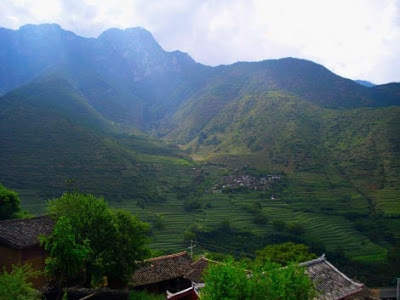 Before the dust-cloud could even settle, a woman appeared. She had a leathery face and a walking stick that still resembled the branch it once was. When I called to her, she hobbled over and, looking up at me, said, “Shitoucheng?” With a smile, she beckoned me to follow, and started down a rocky trail at the road's end. Feeling again like a leaf in the wind, I followed.As we descended, the sun sank slowly behind us, cloaking the valley in the shadow of its mountain. Pomegranate trees were everywhere, their swollen red fruit littering the trail. Soon, we had arrived at Shitoucheng.It was everything that I had dared to hope for. No cars, no tourists and no phone signal. The village was perched high above the great Yangtze River, swaddled among rice terraces on the steep mountainside. Its houses were simple, built from mud bricks, and their overlapping tiled roofs formed the scales of an old, grey dragon in the white dusk.A group of men smoked thoughtfully over an intense game of Mahjong. Night loomed, and the village was quiet but for the trickle of irrigated water and the gentle clip clop of a donkey's hoofs. The old woman led me along the cobbled streets to the only guesthouse in the village: her home. At night, after sharing dinner with my host and her family, I tried to count the number of strangers who had helped me that day. The experience of travel is always influenced the most by the people whose company you keep, and today I had been especially lucky. I thought of their unsolicited kindness and toasted them silently in the dark. Before bed, I remembered I needed to return to Lijiang in just two days' time. I found my host and asked her about buses back.“Méiyŏu.”
Before the dust-cloud could even settle, a woman appeared. She had a leathery face and a walking stick that still resembled the branch it once was. When I called to her, she hobbled over and, looking up at me, said, “Shitoucheng?” With a smile, she beckoned me to follow, and started down a rocky trail at the road's end. Feeling again like a leaf in the wind, I followed.As we descended, the sun sank slowly behind us, cloaking the valley in the shadow of its mountain. Pomegranate trees were everywhere, their swollen red fruit littering the trail. Soon, we had arrived at Shitoucheng.It was everything that I had dared to hope for. No cars, no tourists and no phone signal. The village was perched high above the great Yangtze River, swaddled among rice terraces on the steep mountainside. Its houses were simple, built from mud bricks, and their overlapping tiled roofs formed the scales of an old, grey dragon in the white dusk.A group of men smoked thoughtfully over an intense game of Mahjong. Night loomed, and the village was quiet but for the trickle of irrigated water and the gentle clip clop of a donkey's hoofs. The old woman led me along the cobbled streets to the only guesthouse in the village: her home. At night, after sharing dinner with my host and her family, I tried to count the number of strangers who had helped me that day. The experience of travel is always influenced the most by the people whose company you keep, and today I had been especially lucky. I thought of their unsolicited kindness and toasted them silently in the dark. Before bed, I remembered I needed to return to Lijiang in just two days' time. I found my host and asked her about buses back.“Méiyŏu.”_____________________________________________
Joel Hindson is a young British traveler who loves few things more than adventure and exploration. When he's not wandering around the world, he's either writing about it or baking chocolate-chip cookies. He has twice won the Telegraph's Just Back travel writing competition, and writes regularly on teaisfortravel.wordpress.com.
Published on August 06, 2015 06:30
August 4, 2015
Travel Essay Contest -- The Finalists

First, I want to say thank you to all the talented writers who participated in the 2015 I Must Be Off! Travel Essay Contest. I feel as if I've been around the world 300 times with you all, and I'm sure this year's judge, Catherine Sweeney, feels the same way. This year's round-up of travel writing has been adventurous, humorous, informative, initimate and--most of all--global. Writers from 43 countries and from every continent (except the writer-poor Antarctica) entered the competition.
While the highest percentage of writers came from the USA, large numbers of entries poured in from Nigeria, India, Mexico, the UK, Canada and Spain. It was also great to see travel writing from countries as far-flung as Azerbaijan, Sri Lanka and Zimbabwe. Sadly, there was not one entry from New Zealand or Iceland, but Ghana, Korea and Argentina were all well represented. And there was something interesting in all of them.
If your entry did not make it into the semifinal or final round of the competition, please don't be discouraged. There is always next year! A writer myself who submits a lot, I appreciate the opportunity to revise when I get a rejection.
I'd also like to thank this year's judge, Catherine Sweeney, whose excitement for the entries has been infectious. Her passion for travel and her talent for writing about her life of travel inspire me. Be sure to check out Traveling with Sweeney when you have a chance.
So, without further ado (and probably because you've already scrolled down to see them) we are excited to announce the Top 10, all of whom will be published at I Must Be Off! in August. The winners--which have already been decided by Catherine Sweeney--will be announced on September 30, at which time a Readers' Choice award based on the number of unique hits* and comments** will also be announced.
The Finalists
Barbara Amalberti -- "Vientiane: Then and Now"
Gabriella Brand -- "Burning my Boots in Coba Fisterra"
Gillian Brown -- "Crossing the Gibb"
Chris Galvin -- "Discovering Hến Rice in Central Việt Nam"
Pamela Hensley -- "An Island in the Baltic Sea"
Joel Hindson -- "A Leaf in the Wind"
David Joseph -- "Sweet Homes"
Sofia Lavista -- "Feathered Nights"
Maricarmen Ferrant -- "A Vision Called Tutotepec"
Stacey Venzel -- "On a Terrace in Peru"
Good luck to everyone!
I must be off,
Christopher
*Weighted by how long the entry has been live on the site.
**Positive or negative doesn't matter. Only the total number of comments will count. So if you have nothing nice to say, say nothing at all.
_______________________________________________
Christopher Allen is the author of Conversations with S. Teri O'Type (a Satire), an episodic adult cartoon about a man struggling with expectations. Allen's writing has appeared in Indiana Review, Night Train, Quiddity, SmokeLong Quarterly: the Best of the First Ten Years anthology, Prime Number Magazine, Literary Orphans, Contrary, [PANK] blog, Necessary Fiction, Word Riot, Bootsnall Travel, Chicken Soup for the Soul and over 100 other good places. A finalist at Glimmer Train in 2011 and the winner of the Ginosko Literary Journal's Flash Fiction Award in 2015, Allen has been nominated for Best of the Net and the Pushcart Prize twice.
Published on August 04, 2015 10:40
July 26, 2015
Travel Essay Contest -- Semifinalists
We're excited to announce the titles of the 30 semifinalists in the 2015 I Must Be Off! travel essay contest. If the title of your entry appears on this list, you're still in the running to win. At this point, we can't announce the names of the writers since the judge, Catherine Sweeney, is still deciding on the list of finalists and the winners. Once the competition is over, we'll add the writers' names below and give you a shout out. We loved all of these pieces.
Please do not indicate authorship in the comments as blind judging is still in progress!
A Fan of Kindness
A Leaf in the Wind
A View of One's Own
A Vision Called Tutotepec
An Island in the Baltic Sea
Auroville
Austral Summer 2015
Buffs and Mountain Men
Burning My Boots in Cabo Fisterra
Crossing the Gibb
Delirium
Discovering Hen Rice
An Embarrassment of Riches
Feathered Nights
Festivals, Freedom, Fish, and Fireworks
Finding Home
Garbage in the Trees (original essay untitled)
Greek Islands Memory
Horsing Around in Karnataka
Laos
Loving Lost Memories
Nothing is Out of Reach
On a Terrace in Peru
Space Blanket
Sweet Homes
The Jungle Diaries
The Portuguese Decision
Travels in the Land of our Ancestors (Would the writer of this piece please contact me via e-mail at your earliest convenience?)
Vientiane
Where We Were Supposed to Be
Wondering what happens now? Go HERE .
Much luck to all of you!
I must be off,
Christopher
_________________________________________
Christopher Allen is the author of Conversations with S. Teri O'Type (a Satire), an episodic adult cartoon about a man struggling with expectations. Allen's writing has appeared in Indiana Review, Night Train, Quiddity, SmokeLong Quarterly: the Best of the First Ten Years anthology, Prime Number Magazine, Contrary, [PANK] blog, Necessary Fiction, Word Riot, Bootsnall Travel, Chicken Soup for the Soul and over 100 other good places. A finalist at Glimmer Train in 2011 and the winner of the Ginosko Literary Journal's Flash Fiction Award in 2015, Allen has been nominated for Best of the Net and the Pushcart Prize twice.
Please do not indicate authorship in the comments as blind judging is still in progress!
A Fan of Kindness
A Leaf in the Wind
A View of One's Own
A Vision Called Tutotepec
An Island in the Baltic Sea
Auroville
Austral Summer 2015
Buffs and Mountain Men
Burning My Boots in Cabo Fisterra
Crossing the Gibb
Delirium
Discovering Hen Rice
An Embarrassment of Riches
Feathered Nights
Festivals, Freedom, Fish, and Fireworks
Finding Home
Garbage in the Trees (original essay untitled)
Greek Islands Memory
Horsing Around in Karnataka
Laos
Loving Lost Memories
Nothing is Out of Reach
On a Terrace in Peru
Space Blanket
Sweet Homes
The Jungle Diaries
The Portuguese Decision
Travels in the Land of our Ancestors (Would the writer of this piece please contact me via e-mail at your earliest convenience?)
Vientiane
Where We Were Supposed to Be
Wondering what happens now? Go HERE .
Much luck to all of you!
I must be off,
Christopher
_________________________________________
Christopher Allen is the author of Conversations with S. Teri O'Type (a Satire), an episodic adult cartoon about a man struggling with expectations. Allen's writing has appeared in Indiana Review, Night Train, Quiddity, SmokeLong Quarterly: the Best of the First Ten Years anthology, Prime Number Magazine, Contrary, [PANK] blog, Necessary Fiction, Word Riot, Bootsnall Travel, Chicken Soup for the Soul and over 100 other good places. A finalist at Glimmer Train in 2011 and the winner of the Ginosko Literary Journal's Flash Fiction Award in 2015, Allen has been nominated for Best of the Net and the Pushcart Prize twice.
Published on July 26, 2015 16:23
July 16, 2015
I Must Be Off! Travel Essay Contest -- Submissions Now Closed!
 A little digital clock in American Samoa has just flipped over to July 16, meaning that submissions for the
2015 I Must Be Off! Travel Essay Contest
are now officially closed and the judging may commence. With more than 300 submissions from writers in 43 countries, this year's contest has been the biggest yet; we're climbing a mountain of travel writing. Actually, we've been reading your work for the last couple of months--and each time we open an essay, we do so with respect and appreciation for your experience. What adventures you've had! The hard part for us now is to choose the best, and there are so many great writers among you. In the end, what we're looking for is compelling writing.
A little digital clock in American Samoa has just flipped over to July 16, meaning that submissions for the
2015 I Must Be Off! Travel Essay Contest
are now officially closed and the judging may commence. With more than 300 submissions from writers in 43 countries, this year's contest has been the biggest yet; we're climbing a mountain of travel writing. Actually, we've been reading your work for the last couple of months--and each time we open an essay, we do so with respect and appreciation for your experience. What adventures you've had! The hard part for us now is to choose the best, and there are so many great writers among you. In the end, what we're looking for is compelling writing.What happens now?
We will be announcing the list of semifinalists in the coming week, so be sure to keep an eye on I Must Be Off!. If your name appears on this list, you are still in the running; if your name appears on this list, you are an amazing writer. We loved your piece. You've created a sense of place that rises above the ordinary. Your command of the language is stunning. You have something to say that grips your readers and doesn't let them go. I wish we could have 30 winners in this competition, but we can't. We have to narrow it down.
Finalists will be informed by August 1.
The top essays will be published at I Must Be Off! in August without indication of the winners or the ranking chosen by this year's judge, Catherine Sweeney. We do it this way because at I Must Be Off! there is also a Readers' Choice Award based on the number of unique hits and comments tallied on September 30, and we don't want the Readers' Choice Award skewed by the results of the main competition. Catherine Sweeney's choices will be made public on September 30 as well, so mark this date on your calendar.
Good luck to you all. And thank you again for allowing us the opportunity of reading your work. If you have not made it into the semifinalist round, please don't be discouraged. The competition has been overwhelmingly fierce this year. As a writer myself who submits a lot and gets rejected a lot, I know rejection is an opportunity to look at my story again with new eyes. Sometimes rejection is just the beginning of a great story.
Keep traveling. Keep writing.
I must be off,
Christopher
______________________________________________
Christopher Allen is the author of Conversations with S. Teri O'Type (a Satire), an episodic adult cartoon about a man struggling with expectations. Allen's writing has appeared in Indiana Review, Night Train, Quiddity, SmokeLong Quarterly: the Best of the First Ten Years anthology, Prime Number Magazine, Contrary, [PANK] blog, Necessary Fiction, Word Riot, Bootsnall Travel, Chicken Soup for the Soul and over 100 other good places. A finalist at Glimmer Train in 2011 and the winner of the Ginosko Literary Journal's Flash Fiction Award in 2015, Allen has been nominated for Best of the Net and the Pushcart Prize twice.
Published on July 16, 2015 03:00



